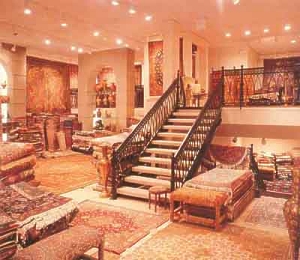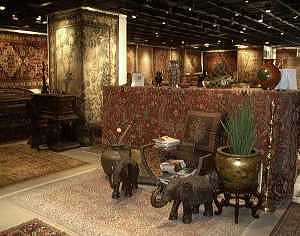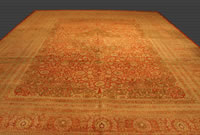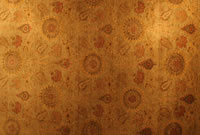 Abrahams Oriental Rugs and Dhurries was established in 1974 as a small Oriental Rug import company at 7101 Beechnut in Houston. The first rug store was opened in August of 1975 at 6120 Richmond, and the size was only 800sq. ft. We were mainly importing Oriental Rugs and Dhurries from India and selling to various showrooms in the Decorative Center. In 1980, we opened a trade showroom at 5120 Woodway, in the Decorative Center, which was about 2,500 sq. ft. During 1984 we moved our retail showroom from 6120 Richmond to 4003 Westheimer in the Highland Village. In 1985 we expanded our showroom at 5120 Woodway and also acquired an adjacent showroom which added 1,800 sq. ft.
Abrahams Oriental Rugs and Dhurries was established in 1974 as a small Oriental Rug import company at 7101 Beechnut in Houston. The first rug store was opened in August of 1975 at 6120 Richmond, and the size was only 800sq. ft. We were mainly importing Oriental Rugs and Dhurries from India and selling to various showrooms in the Decorative Center. In 1980, we opened a trade showroom at 5120 Woodway, in the Decorative Center, which was about 2,500 sq. ft. During 1984 we moved our retail showroom from 6120 Richmond to 4003 Westheimer in the Highland Village. In 1985 we expanded our showroom at 5120 Woodway and also acquired an adjacent showroom which added 1,800 sq. ft.
In July 1991 we expanded both the Decorative Center showroom and the Highland Village showroom. We opened our rug cleaning department, and an Antique Rug restoration department at 3999 Westheimer and added several new lines of very fine rugs in traditional as well as contemporary designs. We also begun to carry Needlepoint Rugs, new Kilims, new Pakistani Persian rugs, and a large selection of Kashmir silk rugs. Thus, we now have about 7,500 sq. ft. of showroom in the Decorative Center (5120 Woodway) and 5,000 sq. ft. of showroom at 5002 Westheimer @ Post Oak Blvd. across from the “Galleria”.
Historical Importance of the Persian or Oriental Rug
In the 17th Century, during India’s Mugal Era, master carpet weavers created elegant rugs depicting realistic expressions of scrolling vines and flowers, the favorite Persian design of the day. Using hand-spun wool and vegetable dyes, these rugs were finely constructed and hand-knotted. The artistic expression and mastery perfected and elevated the art form to world-renowned status.
In their locations of origin, carpets were historically considered as symbols of wealth, prestige and even spiritual power.
Here are some interesting examples:
- Carpets appearing in portraits of early Persian merchants demonstrated their success and illustrated that, as a representative of trade, the individual had functioned as a deputy – one upon whose threshold foreign legions were permitted to kiss and pay homage to the “throne” carpets.
- In provincial capitals, carpets symbolized the presence of the ruler. They were extra-territorial, and the special protection of the owner was bestowed on refugees who succeeded in reaching the carpet’s edge.
- In religious paintings, carpets and other furnishings of splendor were used to make the unusual spiritual significance of the space obvious to the viewer.
- In the “Zafar Name” an excerpt describes Timur’s imperial carpet stating that, in his absence, the carpet had fun.
 The Oriental Rug Today
The Oriental Rug Today
The last twenty years have seen a remarkable revival in interest in the Oriental Rug – both the antique, and the new recreations. Much of this enthusiasm has been generated by the acceptance of Oriental carpets as works of art as they express the creativity of indigenous peoples from fascinating and colorful cultures.
Today, master weavers continue to recreate these beautiful 18th and 19th century rugs, employing the same techniques used over the centuries and recreating museum -quality masterpieces in colors such as burgundy, gold and blue. They are truly the most popular, and in-demand rugs of today.
During the past five years, the authentic handmade Oriental carpet had gained a dynamic new image in the American floor-covering market. Casting off its traditional mystique of exclusively bought at prohibitive cost, the emerging products speak the designer’s language more beautifully and fluent than ever before – contemporary colors, striking new designs, and affordable pricing all combine to make an investment in an Oriental rug even more attractive. For today’s fine home or office, the historical images and unique beauty of an oriental rug provide limitless possibilities for design, and color to enhance personal surroundings. Part of the pleasure of owning is in knowing that the acquisition is virtually a one-of-a-kind work of art.
Trends – Fashion & Design Industries Drive the Process
Once, the traditional Persian carpet model with it’s dark colors, medallion center, limited palette and complex design was the only vision one had of an “Oriental” carpet. Now, carpets are being custom made to exclusively meet American designer standards for design and color. From India, Pakistan, Afghanistan, China, Romania, Turkey and Nepal, new production has been revived, and improved. The looms are now managed to make the industry more sensitive to the fashionable colors of today, in answer to the American designer’s desire to adopt the use of pattern, and ornamentation in their creation of rich, visual interior experiences.
Modern Oriental carpet importers have greatly increased their commitment to the American designer, bringing in a variety of designs, colors and sizes to market and taking cues for collocation from the fashion and home furnishings industry. The somber, brooding tones that were so popular during the first half of the century are being complemented by pastels and primary colors. Saturated colors such as midnight blue, forest green, burgundy and even black are also appearing in the rugs coming from India, Pakistan, Nepal and Tibet.
The industry responds with affordability and the near-perfect accessory
The Oriental carpet industry is recognizing the shift in the market toward not only more choices, but quality and value. There is a segment of the market that is very price-sensitive and there are attractive options for this group in the Oriental rug market. At the same time, there is increasing demand for higher quality and wider choice of color and designs where price is not the most important factor.
For the designer, the Oriental carpet can be one of the most cost effective items in a furnishing schedule because it can make a strong statement. Some interior designers are selecting carpets with a neutral or uniform color palette, while others prefer a statement with more individual impact. Because of their versatility, Oriental carpets are being specified for installations where the need is for unique colors and patterns to either blend with or stand alone in contrast to more monochromatic surroundings.
Designers are also discovering that due to improvements in modern weaving methods, unit prices are down, making a fine carpet accessible to a much broader market than ever before. In residential and contract interiors, quality and long term value are on the minds of corporate and residential clients alike. As a result, one of the most important aspects of buying an Oriental carpet for a client is knowing your resource and feeling comfortable with the value of the investment being made.
 What’s “Hot”
What’s “Hot”
The “Amritsar ” rug takes its name from a small town that is located roughly 20 miles from the Indo-Pakistan border. It is an area that has produced some of the most collectable and desirable rugs of all time. Their distinctive designs appear as early as the 18th century paintings of Lorenzo Lotto; they are mentioned as part of the booty of the Polish King, John III Sobieski, and they are found in the Savonnerie motifs in the 17th Century. In the 19th Century, the traditional deep indigo color gave way to more subtle earth tones of coral, ivory, gray and olive/sage green. Frequently used as coverings for the floors of mosques, these large rugs also lent themselves to the export trade. Strictly Amritsar have a double weft cotton foundation and are generally piled with good quality wool.
The first distinctive designs from this center were an elaboration of the outlines of octagons and other shapes. These were eventually turned into a fascinating patter of yellow Arabesques in a single unbroken line over the whole field, covering it with lozenge shapes, criss-cross patterns, etc.
The rugs on display in the show room represent some of the finest collections of this type of Persian carpets.
Facts – The Fine Art of Quality Oriental Rug Construction
Durability and beauty are inextricably linked in the authentic hand-make Oriental carpet. The unique construction of these weavings is such that forces on tension and compression are used to strengthen the carpet’s structure. Taut, Pro-tensioned warp threads of strong, twisted wool or cotton yarn are strung on the looms before weaving begins. These warps are then wrapped by the weaver using hundreds of thousands of hand looped knots of color wool. Each one of these knots, which forms the pile of the carpet, is itself pulled in tension white it compresses the two adjacent warps, around which it is tightly wrapped.
Rugs as an Investment
According to the available evidence, rugs show all the signs of a solid investment. A steady rise in price, accompanied by increased demand and a diminishing supply. No wonder the publicity about tangibles as a growing source of investment interest has included rugs. Major periodicals have reported very strong gains in Oriental rugs. Barron’s noted the recent trend in increase in the value of Persian Rugs of fine quality. In the last two years, the Wall Street Journalconfirmed that there were fewer fine examples of Persian rugs on the market than earlier and Business Week stated that the Oriental rugs’ price has increased 1000% over the previous ten years. The article in Barron’s went on to observe that several investment syndicates were reported to have started buying rugs in the 1960s. One syndicate, operating in Europe, evaluated its holdings in Oriental rugs at $9 Million in 1986. The net worth of these holdings is estimated to be worth over $200 Million in 1998.
 The Antique Oriental – Hot to Purchase the Best Value
The Antique Oriental – Hot to Purchase the Best Value
Particularly important when buying an antique Oriental carpet is condition. Being realistic, anyone looking for a carpet in absolutely perfect condition that is 100 years old is going to find it difficult. A premium price will be paid for the rare antique pieces that is unworn. Those carpets do exist, and yes, there are many clients who demand this level of quality at whatever price, but there are quite beautiful carpets available in very good, if not perfect, condition. For the investment made, they provide exceptional value.
Key Guidelines
- Generally, all-over wear is an acceptable condition. Before selecting, consider the traffic pattern where the carpet will be used. It is important to remember that these authentic handmade Oriental carpets are extremely durable by virtue of their construction, and that they have been in use for a number of decades. It is not unlike buying a piece of antique furniture that has been exposed to use over time. Many buyers of antique carpets, as well as with furniture, actually insist in seeing those effects; the mellowed dyes, the idiosyncratic patterns, the irregular size, the general patina that only age can give.
- Good restoration is acceptable, and any reputable dealer will point this out. But, don’t hesitate to inquire. Some re-pilling and reinforcing of the foundation, without altering the value of the carpet is to be expected. Any such large areas should be known and the price adjusted accordingly.
- Determine whether the carpet had been touched-up or painted in areas of extreme wear. Extensive re-piling of worn pieces is expensive.
- An area of potential problem in older Oriental rugs is the condition of the dry-rot, a result of the warp or weft becoming brittle and cracking due to exposure to a damp environment over a period of long time.
Tips on Maintaining the Beauty of Your Priceless Rugs
- If the rug is going to be used under heavy furniture, put plastic caps on the pointed legs to avoid tear on those spots in the long run.
- Once or twice a week, brush the rug in the direction of the pile, never against it, with a medium bristle or nylon brush. A vacuum cleaner can be used as an alternative if it works by suction not rotating brushes.
- Once or twice a year, turn over the rug and beat on the back firmly but not violently with a carpet beater. This will dislodge any dirt or grit which might have become embedded in the base.
- Have an exterminator spray the floor for moth and silverfish. Powder some mothballs and spread on the carpet pad.
- If any liquid should fall on the rug, soak it up immediately with an absorbent material like cotton, wool, or blotting paper. Do not rub the residue in the carpet, but remove with a warm cloth. To remove spots, use soap lather on a clean cloth and do not soak the rug. Dry the wet spot before walking on it. Remove the rug from a wet or damp floor.
- Rugs should be professionally cleaned. All handmade rugs need to be hand washed and stains removed and completely dried, something which Abrahams specializes in.
Abrahams cleaning and restoration department has been working for the family-run business for more than 40 years, repairing slight to severely damaged rugs. Their expertise is unsurpassed in the industry, and their commitment to quality means outstanding results.
As with buying anything of great value, rely on a reputable dealer for guidance and honest representation as to authenticity and condition. With over 25 years experience in Oriental Rugs, Abrahams’ reputation for honesty & quality is unblemished.

